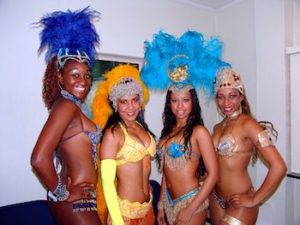
*Samba, also known as samba urbano carioca, is an Afro Brazilian music and dance genre that became popular in the early 20th century. It is celebrated on this date in 1916.
It originated in Rio de Janeiro, Brazil; it has roots in the cultural expression of West Africa and Brazilian folk traditions, especially those linked to the original rural samba of the colonial and imperial periods. Samba is considered one of Brazil's most important cultural phenomena and one of the country's symbols. Present in the Portuguese language, at least since the 19th century, the word “samba” was initially used to designate a “popular dance.”
Over time, its meaning has been extended to a “batuque-like circle dance,” a dance style, and a “music genre.” This process of establishing itself as a musical genre began in the 1910s, and it had its inaugural landmark in the song “Pelo Telefone,” launched on this date in 1916. Despite being identified by its creators, the public, and the Brazilian music industry as “samba,” this pioneering style was more connected from the rhythmic and instrumental point of view to Mozambique than to the samba itself.
During a folkloric research mission in the Northeast Region in 1938, the writer Mário de Andrade noticed that, in rural areas, the term “samba” was associated with the event where the dance was performed, the way of dancing the samba, and the music performed for the dance. The Urban Carioca Samba was influenced by several traditions associated with the universe of rural communities throughout Brazil. The folklorist Oneida Alvarenga was the first expert to list primitive popular dances of the type: coco, Tambor de Crioula, Lundu, Chula or fandango, Baiano, cateretê, Quimbere, Mbeque, Caxambu, and Xiba. To this list, Jorge Sabino and Raul Lody added the samba de coco and the Sambada (also called coco de roda), the Samba de Matuto, the Samba de Caboclo, and the Jongo.
One of the most important forms of dance in the constitution of the choreography of the Carioca Samba, the samba de roda practiced in Bahia's Recôncavo, was typically danced outdoors by a soloist. At the same time, other roda participants took charge of the singing, alternating between solo and chorus parts, and the performance of dance instruments. The three basic steps of Bahian samba de roda were the corta-a-jaca, the separa-o-visgo, the apanha-o-bago, and the little one danced exclusively by women. In their research on Bahian samba, Roberto Mendes and Waldomiro Junior examined that elements from other cultures, such as the Arab pandeiro drum and the Portuguese viola, were gradually incorporated into the singing and rhythm of African batuques, whose most well-known variants were samba corrido and the samba chulado.
In the São Paulo State, another original modality of known rural samba developed, practiced basically in cities along the Tietê River from São Paulo until its middle course and traditionally divided between samba de bumbo. It used only percussion instruments, with bumbo and batuque de umbigada with tambu, quinjengue, and guaiá. Largely composed of two parts (choir and solo) usually performed on the fly, the Partido alto was and still is the most traditional sung variant of rural samba in Rio de Janeiro State. Originating in the Greater Rio de Janeiro, it is the combination, according to Lopes and Simas, of the Bahian samba de roda with the singing of the Calango, as well as a kind of transition between rural samba and what would be developed in the urban environment of Rio from the 20th century. Samba was modernly structured as a musical genre from the neighborhood of Estácio and soon extended to Oswaldo Cruz and other parts of Rio.
Today, synonymous with the rhythm of samba, this contemporary samba brought innovations in rhythm, melody, and thematic aspects. Its rhythmic change based on a new percussive instrumental pattern resulted in a more “Batucado” and syncopated style– as opposed to the inaugural “samba-maxixe”– notably characterized by a faster tempo, longer notes, and a characterized cadence far beyond the simple palms used so far. Also, the “Estácio paradigm” innovated in the formatting of samba as a song, with its musical organization in the first and second parts in both melody and lyrics. In this way, the Sambistas of Estácio created, structured, and redefined the Urban Carioca Samba as a genre in a modern and finished way.
In this establishment process as an urban and modern musical expression, the Carioca Samba played a decisive role in samba schools. It was responsible for defining and legitimizing the aesthetic bases of rhythm and radio broadcasting, greatly contributing to the diffusion and popularization of the genre and its song singers. Thus, the samba has achieved major projection throughout Brazil and has become one of the main symbols of Brazilian national identity.
Once criminalized and viewed with prejudice for its Afro Brazilian origins, the genre has also conquered support between members of the most favored white-Portuguese classes and the country's cultural elite. At the same time that it established itself as the genesis of samba, the “Estácio paradigm” paved the way for its fragmentation into new sub-genres and styles of composition and interpretation throughout the 20th century. Mainly from the so-called “golden age” of Brazilian music, samba received plenty of categorizations, some of which were solid and well-accepted derivative strands.
The modern samba that emerged at the beginning of the 20th century is predominantly in a 2/4-time mark varied with the conscious use of a sung chorus to a batucada rhythm, with various stanzas of declaratory verses. In 2007, the Brazilian National Institute of Historical and Artistic Heritage declared Carioca Samba and three of its matrixes, samba de terreiro, partido-alto, and samba de enredo as cultural heritage in Brazil.